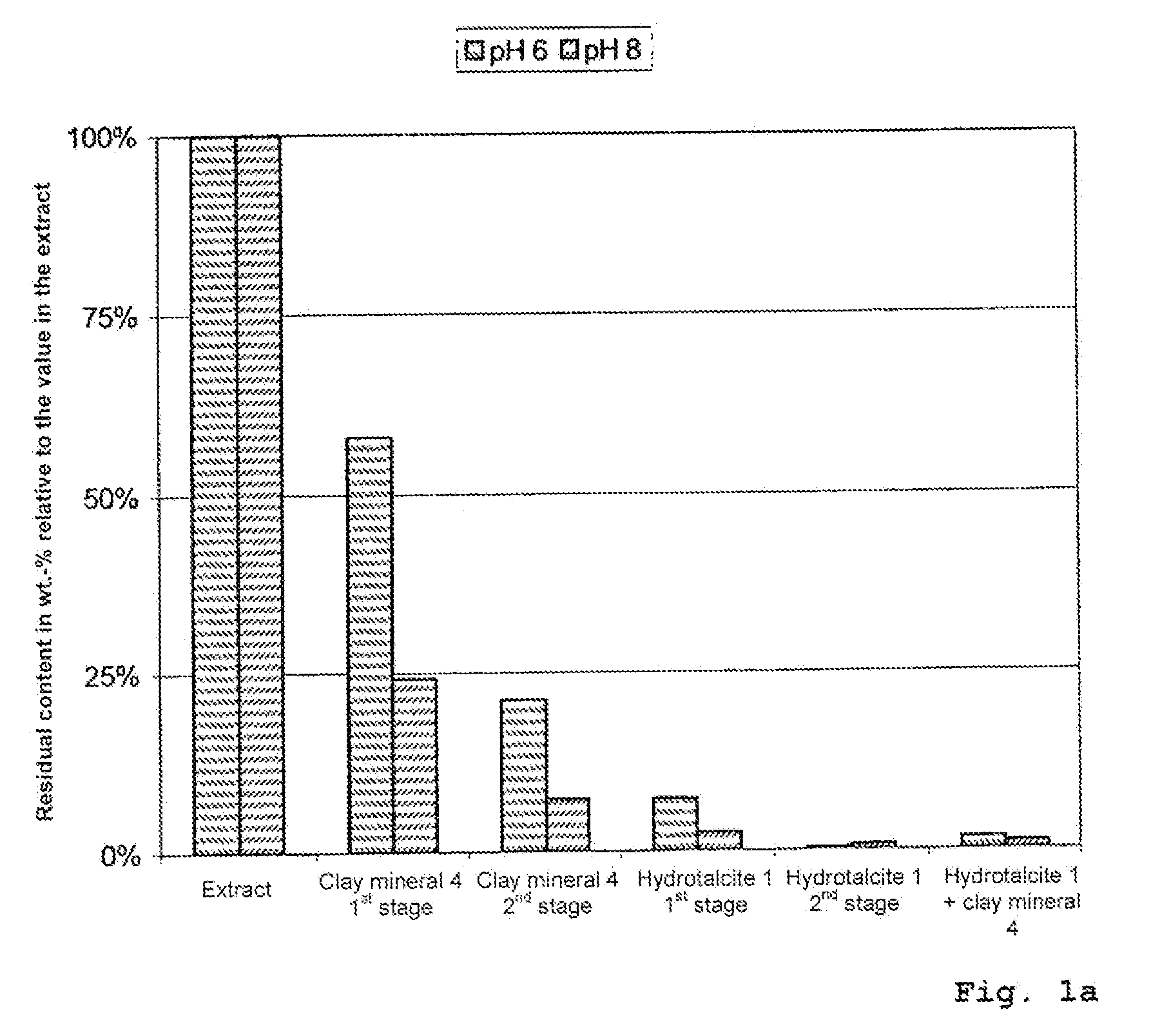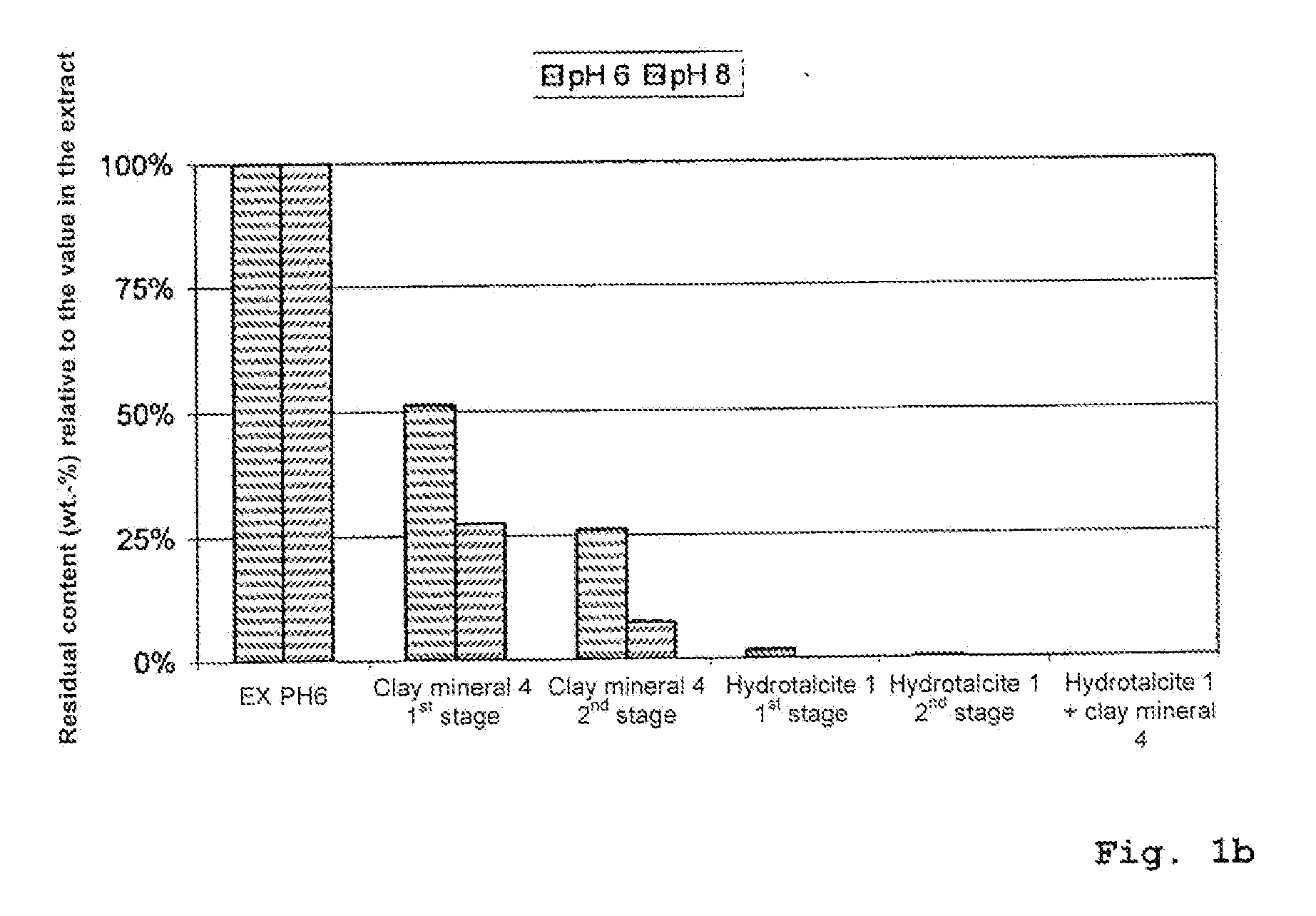Elimination of unwanted accompanying substances from vegetable protein extracts
a technology of vegetable protein extract and unwanted accompanying substances, which is applied in the field of elimination of unwanted accompanying substances from vegetable protein extract, can solve the problems of affecting the colour and quality of vegetable protein concentrate, affecting the taste of rapeseed and sunflower, and a large number of aldehydes and ketones
- Summary
- Abstract
- Description
- Claims
- Application Information
AI Technical Summary
Benefits of technology
Problems solved by technology
Method used
Image
Examples
example 1
Characterisation of the Inorganic Adsorber Materials
[0173]The characterization data of the materials according to the invention are listed in Table 1.
TABLE 1Characterization of inorganic adsorber materialsClay min. 1ClayHydrotalcite 1ParameterCalcigelClay min. 2min. 3Clay min. 4Synthal 696MineralCaSoda-activatedSaponiteCerolite / Hydrotalcitephasebentonitebentonitesmectitein carbonateformBET surface65.5n.d.125.3224.261.4area [m2 / g]Micropore64.9n.d.56.61134.7surface area[m2 / g]External39.3n.d.80.814756.7surface area[m2 / g]Cumulative0.10n.d.0.160.220.482pore volumeaccording toBJH for poreswithdiameters of1.7 to300 nm,[cm3 / g]Average pore6.5n.d.5.24.824.6diameter[4 V / A]according toBET [nm]Average pore9.6n.d.7.26.630.0diameter[4 V / A]according toBJH [nm]Total cation65632020indeterminableexchangecapacity forsmectites[meq / 100 g]Silicateanalysis (%)SiO25753.552.050.520.8Al2O31816.86.63.6Fe2O35.54.31.91.1CaO2.756.01.14.893.8MgO43.926.025.6Na2O1.853.50.320.13K2On.d.1.31.40.8TiO20.40.30.250.12Loss ...
example 2
Examination of the Adsorption of Chlorogenic Acid on Inorganic Adsorber Materials
[0174]Chlorogenic acid is a phenolic acid derivative which occurs in raw sunflower protein. In the tests described below, a chlorogenic acid concentration of 0.2 wt. -% in water was set and the adsorption of the chlorogenic acid was examined on the one hand at pH 6 and with a two molar NaCl solution, on the other hand at pH 8 and with a one molar NaCl solution. A 25 ml solution was used in each case. These are typical conditions, such as are also set for example with extraction from, sunflower proteins in order to clean up the proteins. Commercially available chlorogenic acid (Sigma-Aldrich Chemie GmbH, Taufkirchen) was used for the tests. The relative concentration of the chlorogenic acid before and after the adsorbent treatment was determined by measuring the UV absorbance at 324 nm. The corresponding adsorbent materials were stirred for 15 min. in the buffered chlorogenic solution. The adsorbent mate...
example 3
Adsorption of Sinapine / Sinapinic Acid from Rapeseed Extract
[0177]An extract which predominantly contained sinapine and sinapinic acid was used first to study the suitability of the adsorbent materials according to the invention for eliminating sinapine / sinapinic acid from raw rapeseed proteins. The concentration of sinapine / sinapinic acid was approx. 0.1 wt. -%, the sinapine proportion was approximately 90%. The reduction of the sinapine or sinapinic acid concentration was relative to the starting concentration of the extract used and photometrically examined after half an hour of treatment with the inorganic adsorber materials. The sinapine content was determined at a measuring wavelength of 324 nm by UV spectroscopy. The samples were filtered beforehand through a 0.45 μm syringe filter. The samples were also diluted with methanol for the photometric determination. In each case 25 ml solution was stirred with 1, 2 and 5 wt. -% of the inorganic adsorber materials. After 30 min. cent...
PUM
 Login to View More
Login to View More Abstract
Description
Claims
Application Information
 Login to View More
Login to View More - R&D
- Intellectual Property
- Life Sciences
- Materials
- Tech Scout
- Unparalleled Data Quality
- Higher Quality Content
- 60% Fewer Hallucinations
Browse by: Latest US Patents, China's latest patents, Technical Efficacy Thesaurus, Application Domain, Technology Topic, Popular Technical Reports.
© 2025 PatSnap. All rights reserved.Legal|Privacy policy|Modern Slavery Act Transparency Statement|Sitemap|About US| Contact US: help@patsnap.com



